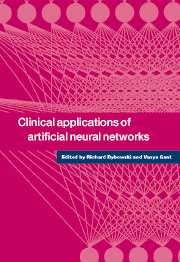Book contents
- Frontmatter
- Contents
- List of contributors
- 1 Introduction
- Part I Applications
- 2 Artificial neural networks in laboratory medicine
- 3 Using artificial neural networks to screen cervical smears: how new technology enhances health care
- 4 Neural network analysis of sleep disorders
- 5 Artificial neural networks for neonatal intensive care
- 6 Artificial neural networks in urology: applications, feature extraction and user implementations
- 7 Artificial neural networks as a tool for whole organism fingerprinting in bacterial taxonomy
- Part II Prospects
- Part III Theory
- Part IV Ethics and clinical prospects
- Index
7 - Artificial neural networks as a tool for whole organism fingerprinting in bacterial taxonomy
Published online by Cambridge University Press: 06 October 2009
- Frontmatter
- Contents
- List of contributors
- 1 Introduction
- Part I Applications
- 2 Artificial neural networks in laboratory medicine
- 3 Using artificial neural networks to screen cervical smears: how new technology enhances health care
- 4 Neural network analysis of sleep disorders
- 5 Artificial neural networks for neonatal intensive care
- 6 Artificial neural networks in urology: applications, feature extraction and user implementations
- 7 Artificial neural networks as a tool for whole organism fingerprinting in bacterial taxonomy
- Part II Prospects
- Part III Theory
- Part IV Ethics and clinical prospects
- Index
Summary
Introduction
There is a continuing need for the rapid and accurate identification of microorganisms, particularly in the clinical laboratory. Recent advances in analytical instruments have allowed the characterization of microbes from their phenotypic make-up, but these techniques tend to produce vast amounts of multivariate data that can be extremely hard to interpret. There is therefore a need to exploit modern statistical and related (chemometric) methods to facilitate automatic microbial identification. A particularly powerful set of methods is based on the use of artificial neural networks (ANNs). Over the last few years the availability of powerful desktop computers in conjunction with the development of several user-friendly packages that can simulate such ANNs has led to these ‘intelligent systems’ increasingly been adopted by the microbial taxonomist for pattern recognition. The nature, properties and exploitation of ANNs for the classification and the identification of microorganisms by whole-organism fingerprinting is reviewed.
In just about every area of microbiology the more rapid, but still accurate, characterization of microorganisms is a desirable objective. In medicine, shortening the time taken to identify a pathogenic bacterium, yeast or fungus will accelerate targeted prescription and should lead to improvements in epidemiological studies. In industry, speedy characterization will allow for better quality control procedures on both raw materials and finished products, and allow accurate microbial screening for isolates producing novel pharmacophores, thus saving time and money.
- Type
- Chapter
- Information
- Clinical Applications of Artificial Neural Networks , pp. 143 - 172Publisher: Cambridge University PressPrint publication year: 2001



